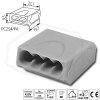Huh? What?
Registered
Wanna check thingsw.
In pic 1, you can see the wiring in the passenger compartment.Just right of center, there is a hole that goes down to the motor block. There are four wires coming out. Blue and grey should be the pickups. Heavier gauge red and black should be the motor. All the other lighter gauge red and black wires are for lights.
All the wiring exits to the left and goes into the luggage compartment.
Pic 1

Pic 2 shows where the wiring ends up in the luggage compartment. In here, all the reds and the blue are wired together and all the blacks and the grey are wired together.
Pic 2

The G8 decoder has hookups for Track +, Track -, Motor +, Motor -, Front light, and Reverse light. It also has 6 function connections, a ground and 3 x 12v+.
According to the Hartland documentation, Red and Grey are positive and Black and Blue are negative. This seems weird to me, as they have the grey (+) bundled with the blacks (-), and the Blue (-) is bundled with the Reds (+). Am I missing something here? Are they using the Blue and Grey leads as returns for the circuit?
So, following the documentation, Blue goes to Track -, Grey to Track +, Heavy Red to Motor +, Heavy Black to Motor -.
I don't think this thing has any reverse lights. so all red light wires would go to the Front light terminal? And then where do the blacks go? Ground?
In pic 1, you can see the wiring in the passenger compartment.Just right of center, there is a hole that goes down to the motor block. There are four wires coming out. Blue and grey should be the pickups. Heavier gauge red and black should be the motor. All the other lighter gauge red and black wires are for lights.
All the wiring exits to the left and goes into the luggage compartment.
Pic 1

Pic 2 shows where the wiring ends up in the luggage compartment. In here, all the reds and the blue are wired together and all the blacks and the grey are wired together.
Pic 2

The G8 decoder has hookups for Track +, Track -, Motor +, Motor -, Front light, and Reverse light. It also has 6 function connections, a ground and 3 x 12v+.
According to the Hartland documentation, Red and Grey are positive and Black and Blue are negative. This seems weird to me, as they have the grey (+) bundled with the blacks (-), and the Blue (-) is bundled with the Reds (+). Am I missing something here? Are they using the Blue and Grey leads as returns for the circuit?
So, following the documentation, Blue goes to Track -, Grey to Track +, Heavy Red to Motor +, Heavy Black to Motor -.
I don't think this thing has any reverse lights. so all red light wires would go to the Front light terminal? And then where do the blacks go? Ground?


